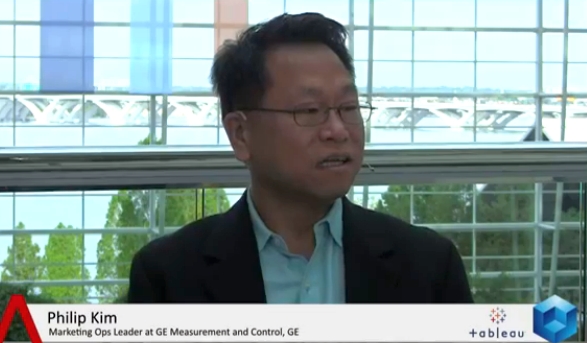 NEWS
NEWS
 NEWS
NEWS
 NEWS
NEWS
![]() The 2013 Tableau Customer Conference is currently unfolding at the Gaylord National Resort & Convention Center in Washington, D.C. The conference key speakers are being interviewed by theCUBE co-hosts Dave Vellante, Wikibon Senior Analyst, and Jeff Kelly, Principal Research Contributor. You can learn more about the event here.
The 2013 Tableau Customer Conference is currently unfolding at the Gaylord National Resort & Convention Center in Washington, D.C. The conference key speakers are being interviewed by theCUBE co-hosts Dave Vellante, Wikibon Senior Analyst, and Jeff Kelly, Principal Research Contributor. You can learn more about the event here.
Their first guest for the day was Philip Kim, Marketing Operations Leader at General Electric Measurement and Control Division. Asked about his responsibilities within the company, Kim described his crew as a “division of GE that specializes in Measurement and control or ‘industrial healthcare’.”
“A lot of the assets that we monitor are the assets that power the economy. We provide equipment, services and software that help monitor that.”
“We collect a lot of data from a variety of different sources and we try to figure out how to get predictivity into that, and how to identify growth areas using the available data, as well as identifying where the cost-savings could come from,” said Kim.
Talk of Big Data has been around for a while, but Vellante wanted to know what has changed: the volume, the power, the economic value? Turns out the answer is not that simple, but Kim reckoned that was a great example of how many things can contribute to the valuation of Big Data. In his opinion, it is the right time for Big Data, and tools like Tableau make it easy for the users to interact with a data set. “There’s a lot of value to be retrieved, if you know how to get it right in the right structure,” Kim said.
Luckily for the GE team, the divisions are working well together, partnering up with the IT crew. They are using Tableau and, from what Kim can share, there haven’t been any of the usual frictions that occur in an organization with the introduction of new elements.
“We didn’t have any push-back from the IT department; it was a blank slate and we were literally starting from ground zero,” Kim explained. “We sat down and tried to identify what is the good use of this amazing technology, in order to drive significant value for our organization. We tried to focus on what we wanted to do with this technology. We wanted to make sure we were saving valuable time – because everyone’s time is limited – and how could we make the day-to-day life less difficult, less challenging.”
Asked about the data architecture, Philip Kim joked that every data architecture is largely based on Excel. However, what they tried to do was to focus on the right question. “Data fragmentation can’t be stopped, but asking the right question can lead to benefits.”
The method is unusual because, as Vellante put it, a lot of practitioners seem to believe that “you don’t know what question to ask until you see the data.” So what would Kim’s advice for the fellow practitioners be, when they don’t know the questions? “There isn’t a solution for everyone; what we did was a series of discussions, a brainstorming session, and what we came up with was a sort of a wishlist.”
As the goal of Tableau is unlocking the power of data for the average business – even for those who are not data scientists – what GE had to do was a simple pragmatic prioritization. Tableau’s mission is to help people see and understand data, and this solution helped their business drive value from their data. Before using Tableau, they were spending too much time analyzing data. Tableau helps the users understand data visually.
“The reason for us to use it as a platform for our analytics was that we were spending far too much time with the data mining, and that didn’t translate enough in benefit. Tableau fixed that very nicely. Tableau is great for taking in entirely large and disparate data sets, and it’s very intuitive,” Kim shared.
![]() Dave Vellante asked what surprised him the most working in his field. Philip Kim believes that first of all “you have to have a passion for this field.”
Dave Vellante asked what surprised him the most working in his field. Philip Kim believes that first of all “you have to have a passion for this field.”
“We like surprises and we like to aim for surprise. If we’re not surprised, we’re probably not pushing ourselves too hard. So, for us, everyday is a little bit of a surprise.”
Wrapping up, he was asked for a bit of advice for his peers. It turns out, when it comes to tech solutions, “simple is underrated.”
“I’ve seen very complicated designs that blew me away, but all the effort and the passion invested wasn’t used because people didn’t understand it,” Kim concluded.
THANK YOU